125 Physics Projects for the Evil Genius (24 page)
Read 125 Physics Projects for the Evil Genius Online
Authors: Jerry Silver

Figure 33-3
Assemble the apparatus shown in
Figure 33-3
. Based on balancing clockwise and counter-clockwise torque, develop other combinations that establish equilibrium. This is based on a demonstration found on the U.C. Berkley Physics Lecture Demonstration website
http://www.mip.berkeley.edu/physics/noteindex.html
(item: A+60+0).
Static equilibrium reflects a balance of forces that results in a collection of objects remaining stable and stationary. The condition for static equilibrium is that the sum of the force and the sum of the torques on an object is zero.
Hanging sign
.
You are hanging a sign for your café that weighs 50 pounds. You have one cable that is 4 feet long and another cable that is 5 feet long. Which one supports more of the weight?
Angles complicate how forces are distributed. This project explores a simple situation similar to hanging a sign with two different length cables.
- 2 spring scales
- mass—(should give close to a full-scale reading in the vertical position on your spring scales)
- string
- 2 ring stands with clamps or comparable support
- key ring
- protractor
- Place the ring stands about 18 inches apart.
- Cut two equal-length sections of string. The strings should be 8 inches, leaving a couple of inches on each side for attaching to the support and the weight.
- Set the spring scales to read zero (in the position they are being used), with no weight hanging from them.
- Hook both of the spring scales to each of the ring stands.
- Attach each string—one side to the key ring and the other side to the clamp on the ring strand.
- The apparatus should be as shown in
Figure 34-1
. - Hang the mass on the key ring.
- Record the reading on each of the spring scales.
- Repeat, using different masses and different string lengths.
- Repeat the previous steps, using different string lengths.
- Based on your evaluation, can you answer the question posed at the beginning of this section?
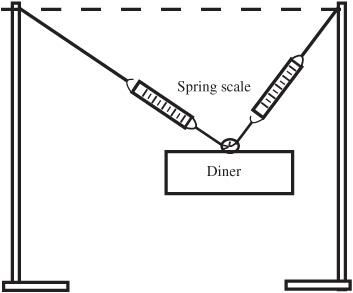
Figure 34-1
In the case of the symmetric supports, the two scales will read the same.
If the strings are different lengths, the
shorter
of the two strings will bear
more
of the weight.
The force in a cable is the combination of the various forces present. The overall force depends on how large each of the forces is and its direction. The method of combining these forces is called
vector addition
.
Tension
is the force in a rope or cable that can change direction without losses by going around a pulley. How do you think the force in each of the cases in
Figure 34-2
compares? Test it out with weights and pulleys.
Each spring scale should read 9.8 newtons, which is the amount of force exerted by gravity on a 1 kg mass.
Tug of war. It is almost impossible to pull a rope supporting a moderate weight tight enough to be perfectly horizontal. The experimental setup is shown in
Figure 34-3
. A gallon milk container filled with water makes a good 4 kg mass to try this with.
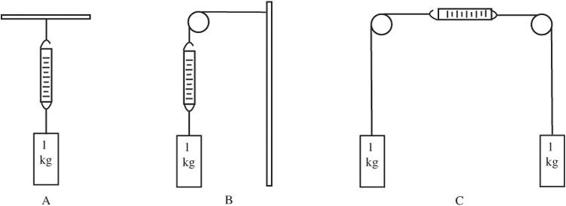
Figure 34-2
How much force is measured by each of the spring scales: A, B, and C
?

Figure 34-3
With a 4 kg mass, it is almost impossible to pull the rope perfectly horizontal
.
To bring the rope to within 5 degrees of horizontal with a 4 kg weight in the middle, you need to pull with a force of 560 newtons (or over 125 pounds). To bring the rope to within 1 degree of horizontal, you need to apply a force of about 2300 newtons (or over 500 pounds).
This exercise shows how a force can be broken down into or resolved into a pair of component forces. The downward force from the suspended sign is supported by cables of various lengths in various directions. This is the type of thinking civil engineers apply on a daily basis—to oversimplify, how strong something (like a bridge cable) needs to be to support a load (like the road surface with cars).
Pressure. Imploding cans
.
How powerful is air pressure? We can answer this by observing what happens when we remove air from where it is normally found.
- empty soda cans
- or a larger rectangular can with a screw-on cap, if you can get one. (These are used for cooking oil or paint thinner, and they can be purchased to do this experiment.)
- hotplate
- beaker
- water
- oven mitt or beaker tongs
- pail of cold water
1. Rinse the can, so it is reasonably clean.
2. Put a small quantity of water (2 tablespoons) in the can.
3. Place the can on the hotplate and keep it there until the water boils and steam comes out of the can (
Figure 35-1
).
4. Carefully remove the can from the hotplate using the mitt or tongs.
5. Quickly immerse the soda can, with steam still evolving, top side down in the water. Observe what happens (
Figure 35-2
).
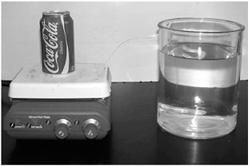
Figure 35-1
A small amount of water in the can is heated
.
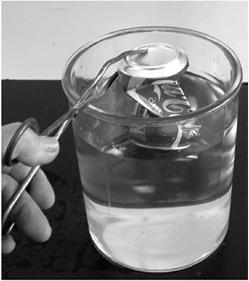
Figure 35-2
Lower air pressure in the can causes it to be crushed
.
Expected Results6. Remove the rectangular can from the hotplate. With steam still coming out of the can, screw on the cap. Wait until it cools in the air or facilitate the cooling with water or ice. (If you are doing this as a demonstration, this may take a while and a sense of drama can be created by pretending that nothing is happening and going on to the next experiment.)
The soda can will be crushed almost instantaneously. The rectangular can may take a few minutes; it gets crushed slowly (as if by a protégé of Darth Vader using the Force).
Air exerts a pressure of 14.7 pounds on every square inch. As the steam in the cans condenses, the air pressure inside the can drops and there is a difference in pressure between the inside and outside of the can. This is primarily the result of the change in state from vapor to liquid and to a lesser degree from the contraction of the gas in the can as it cools. This means a soda can (6.5 inches high and 3 inches in diameter) has a force of over 900 pounds pressing down on its sides!
Try this with a 55-gallon drum as shown in
Figure 53-3
. Use a vacuum pump connected to the drum through a valve to create the pressure difference. This may take some time, but it will be worth the wait. You may want to warn the people you work with that the boom they are about to hear does not require the emergency response team to be sent in.
Air pressure is substantial, exerting a force of nearly 15 pounds for every square inch that it is in contact with.
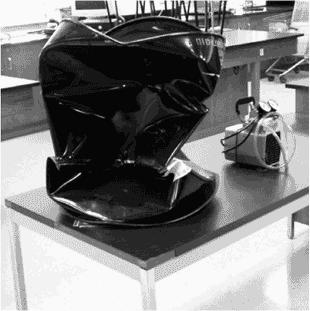
Figure 35-3
Air pressure did this
.
Pressure. Supporting water in a cup
.